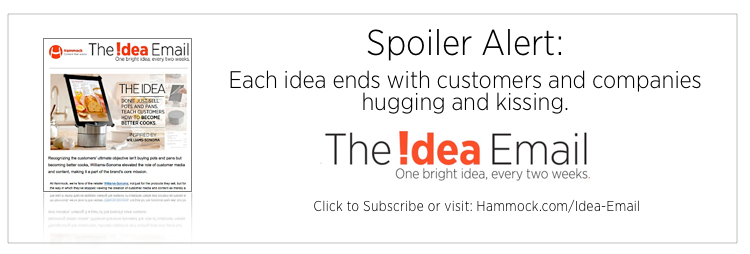[Hammock’s Current Idea Email was released yesterday.


Idea: Design First for the Smallest Screen
Ask a professional photographer to recommend the best camera, and the answer will be something like, “the one you have with you when a great photograph suddenly appears.” The photographer has all sorts of cameras and equipment back at the studio, but they’re useless when a timeless moment occurs elsewhere.
Your corporate website is a lot like those studio cameras. It has all the information and features about your business. But, more and more often, customers need your content in the moment. They may not want or be able to wait until they can visit your studio.
If you haven’t done so already, one day soon* you’ll be using Google on your iPhone. You may be struck by the thought, “I use this phone more than I use my computer.” That’s when you’ll be convinced: Any information created for customers and prospective customers should first be created and designed for the smallest screen they use.
Notice, we didn’t say “add smartphones to your digital marketing plans” or use the trendy buzzwood-hashtag of the nanosecond, #somolo (for, social-mobile-local). We said, “make smartphones your top priority—and not just for marketing or social reasons.” It may help if you stop thinking of those devices as “smartphones” and think of them as computers with really small screens.
And a lot of the time, they’re not even mobile. Look around your business and imagine your employees are customers. Watch how, as they use the big screen in front of them, they keep their smallest screens turned on. They are using the big screen for work, but on their smallest screens, they are interacting with co-workers, reading and replying to email, and looking up something related to what they’re doing on the big screen.
Making the smallest screens your top priority doesn’t mean trying to figure out how to shrink down your current content and design.
At Hammock, we believe strongly in what is being called “responsive design,” an approach to web design that adapts to the type and size of the user’s browser screen. However, we’ve learned through developing such web platforms as SmallBusiness.com that addressing design and content challenges for the smallest screen is where to start, not where to end. We’ve learned, If you start with a design and content plan conceived for a big screen, there’s a temptation to include everything but the kitchen sink.
When you start with the smallest screen, your website may not have all studio-quality flash you can include on a bigger screen, but it will be the best thing you can do for your customer when their need for helpful content suddenly appears.
*The Pew Research Center’s Internet & American Life Project updates this page with statistics about smartphone usage. As of September (before the launch of the latest batch of iPhones), 56% of all American adults are now smartphone adopters. One third (35%) have some other kind of cell phone that is not a smartphone, and the remaining 9% of Americans do not own a cell phone at all.
Photo: This panoramic photo taken with an iPhone by Kevin Baird (via: Flickr) demonstrates what photographers mean when they say the best camera is the one you have with you when a great photograph suddenly appears.
The Idea Email is distributed free, once every two weeks, by Hammock, the customer media and content marketing company. Please share this with friends and colleagues who can subscribe here. We respect your privacy, and each mailing includes a one-click unsubscribe link. We typically feature one or more companies and organizations in each Idea Email. If any company we mention has a relationship to Hammock (as a current or former client, for example), we will include a disclosure.



